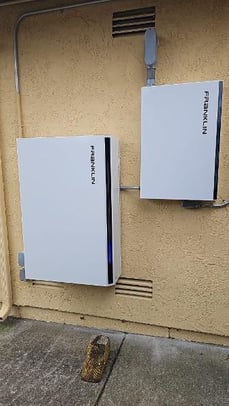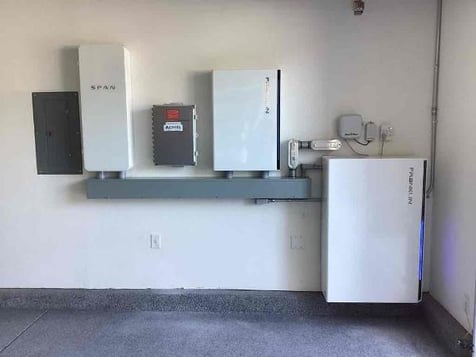The FranklinWH battery is at the forefront of home energy management – an innovative solution we’re excited to offer. Our team is dedicated to providing our customers with the latest energy solutions, prioritizing safety, reliability, and energy independence for households nationwide.
The Franklin Home Power system is a comprehensive whole-home energy management solution designed to seamlessly integrate solar, battery, grid, and generator power sources. The system ensures you're always in control of your energy needs by optimizing the safety, reliability, and efficiency of your home's energy consumption.
What sets the FranklinWH system apart is its unparalleled simplicity – it’s engineered for easy installation, maintenance, and operation. We’re committed to making energy management effortless for homeowners like you, and the FranklinWH battery is a great option if you’re looking for a straightforward system.
The Franklin Home Power System: Your Path to Future-Ready Home Energy
The FranklinWH system isn't just another backup battery system; it's a comprehensive solution designed to meet the evolving needs of homeowners. Engineered with the highest AC battery capacity and industry-leading intelligent controls, FranklinWH sets a new standard for home energy management.
At its core, the Franklin Home Power battery comprises three key components: aPower, the AC battery with a built-in advanced inverter, and aGate, the energy management device that seamlessly connects the grid, loads, generator, and solar system. And lastly, with the FranklinWH App, monitoring your entire home's energy usage is simple.
Its release in 2022 was a game-changer in home energy management, and it’s now widely available across the nation.
With this system, you can store solar or grid energy to power your home during the night and as a backup during brownouts and blackouts. FranklinWH has also focused on time-of-use rate offsetting, helping homeowners save money during peak electricity hours.
Diving into the Franklin Home Power System: Detailed Overview
The FranklinWH battery system comprises three key components, each playing a crucial role in revolutionizing your home's energy management:
aPower Batteries: At the heart of the FranklinWH system are the aPower batteries. These batteries store electricity generated from your solar panels or grid, allowing you to use it at your convenience. Equipped with built-in inverters, the aPower batteries efficiently convert electrical current from AC to DC to charge the battery and from DC to AC to power your home or export excess energy to the grid.
aGate Energy Management Device: The aGate energy management device is the central hub connecting your battery, solar panels, home, and the grid. With sophisticated controls, the aGate regulates the flow of electricity between these systems. In the event of a power outage, the aGate automatically disconnects your home system from the grid, ensuring uninterrupted operation in backup mode.
FranklinWH Monitoring App: Stay connected to your energy system from anywhere with the FranklinWH monitoring app. This intuitive app allows you to monitor and manage your FranklinWH system remotely from your mobile devices, providing real-time insights into your energy usage and system performance.
Franklin Home Power Compatibility
As an AC-coupled battery system, the FranklinWH system offers seamless integration into existing solar systems. Its compatibility with solar inverters simplifies the installation process, making it an ideal choice for homeowners looking to enhance their energy storage capabilities.
Capacity and Scalability
The Franklin Home Power system boasts impressive storage capacity, with each aPower battery unit capable of storing 13.6 kWh of energy. The system's scalability allows for the installation of up to 15 aPower battery units, providing a total energy storage capacity of 204 kWh. While this capacity may seem substantial, it's important to note that most residential homes will never require such extensive storage capacity.
Exploring the Cost of Franklin Home Power: A Closer Look
Determining the exact price of the FranklinWH battery can be influenced by various factors, including the installer, location, and available incentives. Depending on your home's energy usage requirements, you may need to consider multiple battery units, which can impact the total cost. The cost of the battery system can vary depending on factors such as your eligibility for rebates and tax credits, battery capacity, installation fees, and location.
Homeowners and business owners who install solar energy storage systems typically qualify for the Federal Investment Tax Credit (ITC), which since 2020 covers 30 percent of the system’s price. Some solar energy storage systems qualify for a Self-Generation Incentive Program (“SGIP”) rebate in California. SGIP rewards homeowners with solar batteries for their positive influence on the solar grid. If you live in a fire zone, this rebate could cover up to 100% of your cost, when including tax credits. Please read our SGIP blog for more information.
That’s why it’s critical to reach out to an expert who can assist in determining your solar battery estimate.
Exploring the Longevity of Franklin Home Power Batteries
One of the most common questions homeowners have about the FranklinWH system is about the longevity of its batteries. With daily charging and discharging cycles, it's essential to understand how FranklinWH batteries stand the test of time.
The lifespan of the aPower battery, a key component of the Franklin Home Power system, is a critical consideration for homeowners. Designed to withstand daily use, the aPower battery boasts an impressive lifespan. Over time, however, like all rechargeable batteries, it gradually loses some of its ability to hold a charge.
As with any rechargeable device, consider the comparison between the battery life of a brand-new smartphone and one that's a few years old – the difference is noticeable. Similarly, the battery life of your FranklinWH system will naturally deteriorate over time due to regular charging and discharging cycles. This isn't indicative of a product flaw but rather a natural phenomenon observed in all types of batteries.
Understanding Warranty Coverage of FranklinWH Batteries.jpg?width=405&height=304&name=FWH%20(10).jpg)
In addition to considering the lifespan of FranklinWH batteries, it's essential to understand the warranty coverage provided by FranklinWH. The aPower battery, a key component of the system, comes with an impressive 12-year warranty, covering up to 6,000 cycles or 43 MWh throughput (whichever comes first).
FranklinWH guarantees that the battery will maintain at least 70 percent of its capacity to hold a charge during this period, providing homeowners with peace of mind and confidence in their investment. This comprehensive warranty coverage underscores FranklinWH's commitment to delivering exceptional performance and reliability in residential energy management solutions.
Frequently Asked Questions (FAQ):
How much does the Franklin Home Power system cost?
The cost of the Franklin Home Power system can vary depending on factors such as your eligibility for rebates and tax credits, battery capacity, installation fees, and location. Homeowners and business owners who install solar energy storage systems typically qualify for the federal Investment Tax Credit (ITC), which since 2020 covers 30 percent of the system’s price. Some solar energy storage systems qualify for a Self-Generation Incentive Program (“SGIP”) rebate in California. And commercial solar energy systems typically qualify for bonus depreciation. Please reach out to an expert for your solar battery estimate.
How long does a whole home battery backup last?
The duration of a whole home battery backup depends on factors such as the battery capacity and the amount of energy used by the home. Typically, a fully charged whole home battery backup can provide power for several hours to several days, depending on the energy consumption and the size of the battery system.
What size battery do I need to run a house?
The size of the battery needed to run a house depends on factors such as the household's energy consumption, the duration of backup power required during outages, and the availability of alternative energy sources such as solar panels. A professional assessment by a qualified installer can help determine the appropriate size battery system for your specific needs.
How many batteries does it take to power a whole house?
The number of batteries required to power a whole house depends on factors such as the size of the house, the household's energy consumption, and the capacity of the batteries being used. In general, you can expect to need 1-2 batteries to provide sufficient backup power for an average home. A qualified installer can assess your energy needs and recommend the appropriate number of batteries for your home.
Final Thoughts
The Franklin Home Power battery system represents a significant leap forward in residential energy management, offering homeowners unparalleled reliability, efficiency, and peace of mind. With its seamless integration of solar, battery, grid, and generator power sources, the Franklin Home Power system is a comprehensive option for taking control of your energy consumption.
The Citadel Roofing and Solar team is here to guide you every step of the way as you explore your options. With our expertise in roofing and solar installations, we are excited to offer the Franklin battery as part of our commitment to providing comprehensive energy solutions to our customers.
Contact us today to learn more about how the Franklin Home Power battery system can transform your home's energy management. Let Citadel Roofing and Solar be your trusted partner in building a brighter, more sustainable future for your household.
![]()




